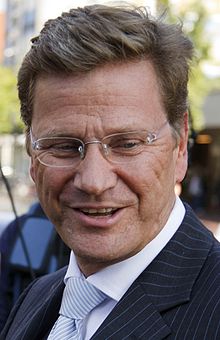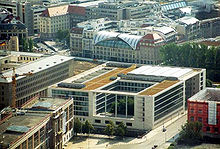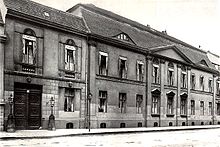- Foreign Office (Germany)
-
Foreign Office Auswärtiges Amt 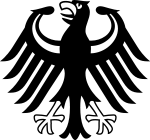
Agency overview Formed 1870 (refoundation 1949) Jurisdiction Government of Germany Headquarters Werderscher Markt 1
10117 BerlinAnnual budget €1.313 billion (2005) Minister responsible Guido Westerwelle, Federal Minister for Foreign Affairs Agency executives Werner Hoyer, Minister of State at the Foreign Office
Cornelia Pieper, Minister of State for EuropeWebsite http://www.auswaertiges-amt.de/diplo/en/Startseite.html 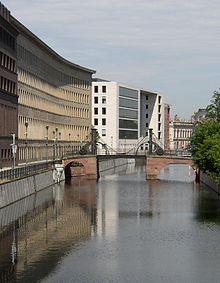 Foreign Office on the Spree river
Foreign Office on the Spree river
The Foreign Office (
 Auswärtiges Amt (help·info), abbr. AA) is the foreign ministry of Germany, a federal agency responsible for both the country's foreign politics and its relationship with the European Union. From 1871 to 1919, it was led by a Foreign Secretary, and since 1919, it has been led by the Foreign Minister of Germany. Since 2009, Guido Westerwelle has served as Foreign Minister and Vice Chancellor, and Werner Hoyer and Cornelia Pieper as Ministers of State.
Auswärtiges Amt (help·info), abbr. AA) is the foreign ministry of Germany, a federal agency responsible for both the country's foreign politics and its relationship with the European Union. From 1871 to 1919, it was led by a Foreign Secretary, and since 1919, it has been led by the Foreign Minister of Germany. Since 2009, Guido Westerwelle has served as Foreign Minister and Vice Chancellor, and Werner Hoyer and Cornelia Pieper as Ministers of State.The primary seat of the ministry is at the Werderscher Markt square in the Mitte district, the historic centre of Berlin.
Contents
History
The Auswärtiges Amt was established in 1870 to form the foreign policy of the North German Confederation, and from 1871 of the German Empire. The Foreign Office was originally led by a secretary of state (therefore not called a ministry), while the Chancellor remained in charge of foreign affairs.
In the first years of the German nation-state under Otto von Bismarck, the Foreign Office on Wilhelmstrasse No. 76 next to the Reich Chancellery had two departments, a political and an economic, legal and consular. After Bismarck's dismissal in 1890 another department for colonial policy was established, spun off as the separate Reichskolonialamt in 1907. In the forefront of World War I the Auswärtiges Amt had to deal with the own foreign policy of Emperor Wilhelm II.
In 1919, the Foreign Office was reorganized and a modern structure was established. It was now under the authority of a foreign minister, though still called Amt for traditional reasons. The most notable head of the Foreign Office during the Weimar Republic was Gustav Stresemann, foreign minister from 1923 to 1929, who strived for a reconciliation with the French Third Republic, which earned him - together with Aristide Briand - the 1926 Nobel Peace Prize. In 1932 Konstantin von Neurath was appointed foreign minister, he also held the office after Hitler became chancellor, finding himself exposed to increasing competition from Nazi politicians like Alfred Rosenberg and Joachim von Ribbentrop, who followed him in 1938. A report written by historians and released by German government in 2010 shows that wartime-era diplomats played an important role in assisting the Nazis in carrying out the Holocaust, and disproved the claim often made after 1945 that German diplomats were "sand in the machine" who acted to moderate the actions of the Nazi regime.[1] [2][3] [4][5]
While Georg Dertinger had been appointed the first minister of foreign affairs of East Germany already in 1949, the Auswärtiges Amt of West Germany, due to the Allied occupation statute was not reestablished until March 15, 1951. Chancellor Konrad Adenauer took the office of the first Foreign Minister in Bonn until the inauguration of Heinrich von Brentano in 1955. Since Willy Brandt served as Foreign Minister of the grand coalition under Kurt Georg Kiesinger from 1966, the office usually was connected with the position of the Vice-Chancellor. From 1974 until 1992 - with a short pause in 1982 - Hans-Dietrich Genscher served as Foreign Minister continuing Brandt's Ostpolitik and playing a vital role in the preparation of German reunification.
In 2000 the Foreign Office was relocated back to Berlin, where it moved into the former Reichsbank building, which from 1959 to 1990 had served as the seat of the Central Committee of the Socialist Unity Party of Germany, enlarged by a newly built annex. The former ministry in Bonn remained a second seat. The Foreign Office has always stressed its continuity and traditions since 1870.
German representation overseas
Main article: Diplomatic missions of GermanyIn addition to the ministry's headquarters in Berlin, Germany has established embassies and consulates around the world.
List of Foreign Secretaries and Foreign Ministers since 1871
Main article: Minister for Foreign Affairs (Germany)See also
- Cabinet of Germany
- Foreign relations of Germany
- Ministry for Foreign Affairs of the German Democratic Republic
References
- ^ Germany - Speech by Federal Minister Westerwelle on the presentation of the study by the Independent Commission of Historians Federal Foreign Office
- ^ canadaeast.com - German foreign minister 'ashamed' of diplomats' role in Holocaust | The Associated Press - Breaking News, New Brunswick, Canada
- ^ Report Confirms German Foreign Ministry Role in Holocaust - TIME
- ^ German foreign minister 'ashamed' of diplomats' role in Holocaust - Winnipeg Free Press
- ^ Niemcy: Szokujący raport. "To nas zawstydza" - Wiadomości w Onet.pl
External links
Federal Ministries of Germany Defence · Justice · Finance · Interior · Foreign · Economics and Technology · Labour and Social Affairs · Family Affairs, Senior Citizens, Women and Youth · Environment, Nature Conservation and Nuclear Safety · Food, Agriculture and Consumer Protection · Economic Cooperation and Development · Health · Transport, Building and Urban Development · Education and ResearchCoordinates: 52°30′53″N 13°23′58″E / 52.51472°N 13.39944°E
Categories:- German Federal ministries
- German Ministry of Foreign Affairs
- Foreign affairs ministries
- Foreign relations of Germany
- Ministries established in 1870
Wikimedia Foundation. 2010.

